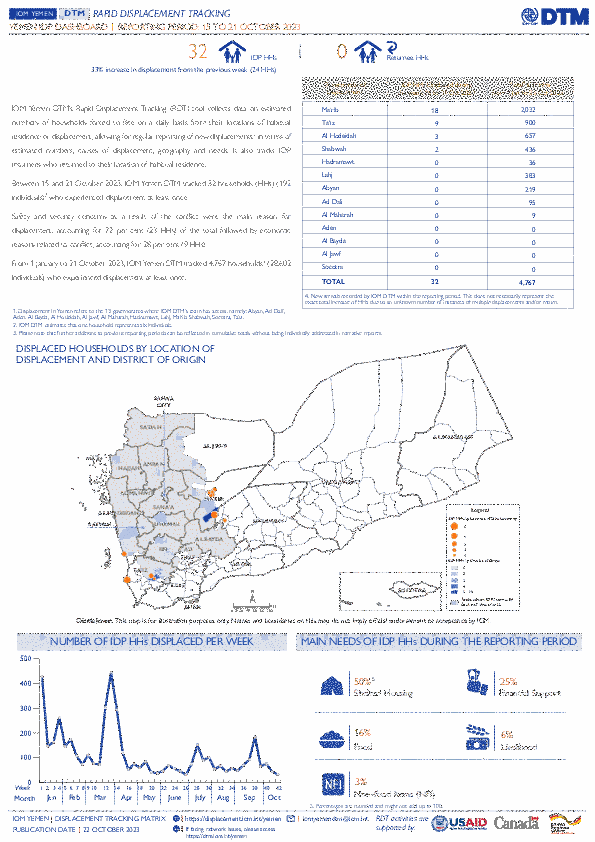-
Countries
-
Data and Analysis
-
Special Focus
-
Crisis Responses
Yemen — Rapid Displacement Tracking Update (15 - 21 October 2023)

Contacto
DTM Yemen, iomyemendtm@iom.int
Idioma
English
Ubicación
Yemen
Fecha de instantánea
Oct 15 2023
Oct 21 2023
Actividad
- Rapid Emergency Registration
- Mobility Tracking
IOM Yemen DTM’s Rapid Displacement Tracking (RDT) tool collects data on estimated numbers of households forced to flee on a daily basis from their locations of origin or displacement, allowing for regular reporting of new displacements in terms of estimated numbers, geography, and needs. It also tracks returnees who returned to their location of origin.
From 1 January to 21 October 2023, IOM Yemen DTM tracked 4,767 households (HH) (28,602 Individuals) who experienced displacement at least once.
Between 15 and 21 October 2023, IOM Yemen DTM tracked 32 households (192 individuals) displaced at least once. The majority of people moved into/within the following governorates and districts:
- Ma’rib (18 HHs) – Ma’rib (10 HHs), Harib (5 HHs), Ma’rib City (3 HHs) districts. Most displacements in the governorate originated from Ma’rib and Ibb.
- Ta’iz (9 HHs) – Al Makha (5 HHs), Jabal Habashi (3 HHs), Al Maafer (1 HH) districts. Most displacements in the governorate originated from Ta’iz and Ibb.
- Al Hodeidah (3 HHs) – At Tuhayta (3 HHs) district. All displacements in the governorate were internal.
The majority of people moved from the following governorates and districts:
- Ma’rib (13 HHs) – Harib (10 HHs), Al Jubah (2 HHs), Raghwan (1 HH) districts.
- Ta’iz (8 HHs) – Al Maafer (4 HHs), Sabir Al Mawadim (3 HHs), Jabal Habashi (1 HH) districts.
- Ibb (5 HHs) – Al Qafr (2 HHs), Badan (2 HHs), As Sabrah (1 HH) districts.
